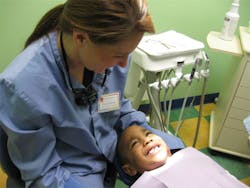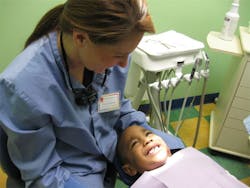December 28, 2012
Updated March 21, 2013
Note: The original photo has been removed
In two states in our union, there is a mid-level dental professional that is licensed to perform basic dental functions that go beyond what an assistant can do but do not compare to the scope of the dentist. Dental therapists, likened to nurse practitioners or physician assistants, are currently practicing in Minnesota and Alaska in an effort to decrease the health disparity evident in the American population.
Working under the supervision of a dentist, dental therapists can extract primary teeth and put in crowns and spacers. Minnesota requires that DTs graduatefrom an approved bachelor’s or master’s degree program that takes about two-and-a-half years to complete. They are also required to work in a practice that includes 50% of patients who are on medical assistance or are low income.
Dental hygienists who are interested in the role can receive a higher-level license as an advanced dental therapist (ADT) after completing 2,000 hours of clinical experience as a dental therapist and graduating from the program. In addition to the basic procedures performed by DTs, ADTs can extract adult teeth after receiving authorization from the dentist (though the doctor does not have to be on site at the time of procedure). At least eight other states have considered using these mid-level providers. California, Kansas, Maine, and New Hampshire have all considered DTs as a way to expand oral health care to those in need.
When former Surgeon General David Satcher spoke at aconference to address the nation’s oral health earlier this year, he illuminated that there was a shortage of dentists in the U.S. and proposed four solutions to this issue, focusing on expanding access to care. Two of his suggestions were to create new dental providers and to build a cadre of dental practitioners – which could include dental therapists.
Not everyone believes mid-level providers are the best idea, however. Dr. Bill Calnon, former president of the American Dental Association, said in an interview with PBS during his presidency that it was not a lack of dentists, but a “maldistribution” of dentists that resulted in millions of Americans not having access to dental care.
RELATED: Dental therapy fact sheet
RELATED: Dental therapist program in new video
This “maldistibution” has also been identified as a “dental desert.” According to the Department of Human Services, the number of people living in a health professional shortage area, or HPSA, was 44.6 million in November 2012. DHS asserts that it would take 8,962 providers to meet the need for oral care in these areas, which would mean 3,000 patients for each dentist.
The ADA has offered an alternative solution: community dental health coordinators (CDHC). Continuing on the idea that there is not a shortage of practitioners, but that there are indeed dental deserts, CDHCs “are community health workers with dental skills focusing on education and prevention” and their aim is to expand access to underserved communities, such as “Federally Qualified Health Centers, the Indian Health Service and tribal clinics, state or county public health clinics, or private practitioners serving dentally-underserved areas.”
RELATED: Dental Therapists help expand access to dental care for Alaska Natives
RELATED: Dental therapist study: Kellogg
Unlike DTs, CDHCs would not have a care-giving role similar to the hygienist, assistant, or dentist. Instead, they would “work in health and community settings to collect information to assist the dentist in the triage of patients and address the social, environmental, and health literacy issues facing the community population.” The role sounds similar to that of a community health worker (CHW), but the ADA insists that unlike a CHW, a CDHC has clinical dental skills.
The ADA began a pilot program for CDHC training, which concluded at the end of the fall 2012 semester and says that while mid-level providers are there to “drill, fill, and extract,” the CDHC focuses on the root causes of the disease and the lack of prevention and oral health education among underserved populations.
RELATED: Op-ed: Dental therapists could help people get care needed in Washington state
RELATED: Op-ed: Dental therapists not the right fit for Washington state
Regardless of the disagreements on how to tackle the problem – and, indeed, disagreements about what the problem is, exactly – it’s in evident agreement that prevention is the strongest option for improving our nation’s oral health, but what about those who didn’t have preventive care?
It could be that the solution to improving the nation’s oral health lies not in one solution, but in a balanced approach that takes ideas from both sides. A commenter onthis article with the moniker “Larryhill” said it well:
“Rather, what is necessary is a balanced approach that recognizes both that we need to do a much better job of disease prevention AND that, because of our past failures to do so, there are millions of Americans who suffer from the disease we failed to prevent.”
In March 2013, The Pew Charitable Trusts published a brief on dental therapists. Read Dental Therapists in New Zealand: What the Evidence Shows.


